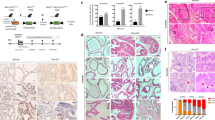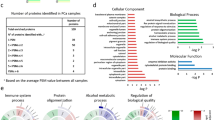Abstract
PCGEM1 is a novel, highly prostate tissue-specific, androgen-regulated gene. Here, we demonstrate that PCGEM1 expression is significantly higher in prostate cancer (CaP) cells of African-American men than in Caucasian-American men (P=0.0002). Further, increased PCGEM1 expression associates with normal prostate epithelial cells of CaP patients with a family history of CaP (P=0.0400). PCGEM1 overexpression in LNCaP and in NIH3T3 cells promotes cell proliferation and a dramatic increase in colony formation, suggesting a biological role of PCGEM1 in cell growth regulation. Taken together, the cell proliferation/colony formation-promoting functions of PCGEM1 and the association of its increased expression with high-risk CaP patients suggest the potential roles of PCGEM1 in CaP onset/progression, especially in these high-risk groups.
This is a preview of subscription content, access via your institution
Access options
Subscribe to this journal
Receive 50 print issues and online access
$259.00 per year
only $5.18 per issue
Buy this article
- Purchase on Springer Link
- Instant access to full article PDF
Prices may be subject to local taxes which are calculated during checkout




Similar content being viewed by others
Abbreviations
- CaP:
-
prostate cancer
- PSA:
-
prostate-specific antigen
- FBS:
-
fetal bovine serum
- LCM:
-
laser capture microdissection
- RT:
-
reverse transcription
- H&E:
-
hematoxylin–eosin
References
Askew DS, Li J and Ihle JN . (1994). Mol. Cell. Biol., 14, 1743–1751.
Brantley MA and Harbour JW . (2000). Cancer Res., 60, 4320–4323.
Brawley OW, Knopf K and Thompson I . (1998). Semin. Urol. Oncol., 16, 193–201.
Bussemakers MJ, van Bokhoven A, Verhaegh GW, Smit FP, Karthaus HF, Schalken JA, Debruyne FM, Ru N and Isaacs WB . (1999). Cancer Res., 59, 5975–5979.
Cussenot O and Valeri A . (2001). Eur. J. Intern. Med., 12, 11–16.
DeKok JB, Verthaegh GW, Roelofs RW, Hessels D, Kiemeney LA, Aalders TW, Swinkels DW and Schalken JA . (2002). Cancer Res., 62, 2695–2698.
Dhanasekaran SM, Barrette TR, Ghosh D, Shah R, Varambally S, Kurachi K, Pienta KJ, Rubin MA and Chinnaiyan AM . (2001). Nature, 412, 822–826.
Guo Y, Sigman DB, Borkowski A and Kyprianou N . (2000). Prostate, 42, 130–136.
Hao Y, Crenshaw T, Moulton T, Newcomb E and Tycko B . (1993). Nature, 365, 764–767.
Isaacs W, De Marzo A and Nelson WG . (2002). Cancer Cell, 2, 113–116.
Knudsen ES and Wang JY . (1996). J. Biol. Chem., 271, 8313–8320.
Lottin S, Adrianssens E, Dupressoir T, Berteaux N, Montpellier C, Coll J, Dugimont T and Curgy JJ . (2002). Carcinogenesis, 23, 1885–1895.
Luo J, Zha S, Gage WR, Dunn TA, Hicks JL, Bennett CJ, Ewing CM, Platz EA, Ferdinandusse S, Wanders RJ, Trent JM, Isaacs WB and De Marzo AM . (2002). Cancer Res., 62, 2220–2226.
Magee JA, Araki T, Patil S, Ehrig T, True L, Humphrey PA, Catalona WJ, Watson MA and Milbrandt J . (2001). Cancer Res., 61, 5692–5696.
Moul JW, Sesterhenn IA, Connelly RR, Douglas T, Srivastava S, Mostofi FK and McLeod DG . (1995). JAMA, 274, 1277–1281.
Nelson WG, De Marzo AM, Deweese TL, Lin X, Brooks JD, Putzi MJ, Nelson CP, Groopman JD and Kensler TW . (2001). Ann. NY Acad. Sci., 952, 135–144.
Paris PL, Kupelian PA, Hall JM, Williams TL, Levin H, Klein EA, Casey G and Witte JS . (1999). Cancer Epidemiol. Biomarkers Prev., 8, 901–905.
Platz EA, Rimm EB, Willett WC, Kantoff PW and Giovannucci E . (2000). J. Natl. Cancer Inst., 92, 2009–2017.
Powell IJ . (1998). Semin. Urol. Oncol., 16, 221–226.
Rubin MA, Zhou M, Dhanasekaran SM, Varambally S, Barrette TR, Sanda MG, Pienta KJ, Ghosh D and Chinnaiyan AM . (2002). JAMA, 287, 1662–1670.
Singh D, Febbo PG, Ross K, Jackson DG, Manola J, Ladd C, Tamayo P, Renshaw AA, D'Amico AV, Richie JP, Lander ES, Loda M, Kantoff PW, Golub TR and Sellers WR . (2002). Cancer Cell, 1, 203–209.
Small EJ . (1998). Curr. Opin. Oncol., 10, 244–252.
Srikantan V, Zou Z, Petrovics G, Xu LL, Augustus M, Davis L, Livezey JR, Connell T, Sesterhenn IA, Yoshino K, Buzard GS, Mostofi FK, McLeod DG, Moul JW and Srivastava S . (2000). Proc. Natl. Acad. Sci. USA, 97, 12216–12221.
Szymanski M and Barciszewski J . (2002). Genome Biol., 3, 51–58.
Tam W, Ben-Yehuda D and Hayward WS . (1997). Mol. Cell. Biol., 17, 1490–1502.
Tam W, Hughes SH, Hayward WS and Besmer PJ . (2002). Virology, 76, 4275–4286.
Taylor JA, Hirvonen A, Watson M, Pittman G, Mohler JL and Bell DA . (1996). Cancer Res., 56, 4108–4110.
Varambally S, Dhanasekaran SM, Zhou M, Barrette TR, Kumar-Sinha C, Sanda MG, Ghosh D, Pienta KJ, Sewalt RG, Otte AP, Rubin MA and Chinnaiyan AM . (2002). Nature, 419, 624–629.
Welsh JB, Sapinoso LM, Su AI, Kern SG, Wang-Rodriguez J, Moskaluk CA, Frierson Jr HF and Hampton GM . (2001). Cancer Res., 61, 5974–5978.
Xu J, Zheng SL, Komiya A, Mychaleckyj JC, Isaacs SD, Hu JJ, Sterling D, Lange EM, Hawkins GA, Turner A, Ewing CM, Faith DA, Johnson JR, Suzuki H, Bujnovszky P, Wiley KE, DeMarzo AM, Bova GS, Chang B, Hall MC, McCullough DL, Partin AW, Kassabian VS, Carpten D, Bailey-Wilson JE, Trent JM, Ohar J, Bleecker ER, Walsh PC, Isaacs WB and Meyers DA . (2002). Nat. Genet., 32, 321–325.
Xu LL, Srikantan V, Sesterhenn IA, Augustus M, Dean R, Moul JW, Carter KC and Srivastava S . (2000). J. Urol., 163, 972–979.
Yan H, Dobbie Z, Gruber SB, Markowitz S, Romans K, Giardiello FM, Kinzler KW and Vogelstein B . (2002). Nat. Genet., 30, 25–26.
Yang G, Addai J, Ittmann M, Wheeler TM and Thompson TC . (2000). Clin. Cancer Res., 6, 3430–3433.
Acknowledgements
We thank Dr. Gregory Buzard for critically reading this manuscript. This research was supported by Grant #1RO1CA85596-01 from the National Institutes of Health to SS. The opinions and assertions contained herein are the private views of the authors and are not to be considered as reflecting the views of the US Army or the Department of Defense.
Author information
Authors and Affiliations
Corresponding author
Rights and permissions
About this article
Cite this article
Petrovics, G., Zhang, W., Makarem, M. et al. Elevated expression of PCGEM1, a prostate-specific gene with cell growth-promoting function, is associated with high-risk prostate cancer patients. Oncogene 23, 605–611 (2004). https://doi.org/10.1038/sj.onc.1207069
Received:
Revised:
Accepted:
Published:
Issue Date:
DOI: https://doi.org/10.1038/sj.onc.1207069
Keywords
This article is cited by
-
PCGEM1 promotes cell proliferation and migration in endometriosis by targeting miR-124-3p-mediated ANTXR2 expression
BMC Women's Health (2023)
-
PCGEM1 promotes proliferation, migration and invasion in prostate cancer by sponging miR-506 to upregulate TRIAP1
BMC Urology (2022)
-
Liver-specific lncRNA FAM99A may be a tumor suppressor and promising prognostic biomarker in hepatocellular carcinoma
BMC Cancer (2022)
-
LncRNA weighted gene co-expression network analysis reveals novel biomarkers related to prostate cancer metastasis
BMC Medical Genomics (2022)
-
Transcriptional landscape of PTEN loss in primary prostate cancer
BMC Cancer (2021)



